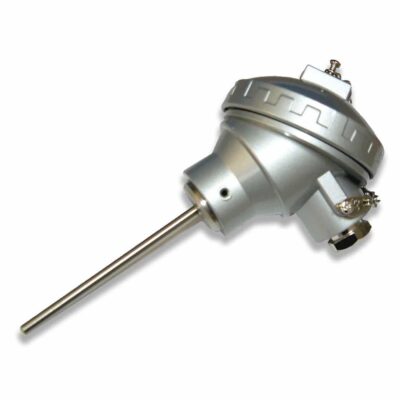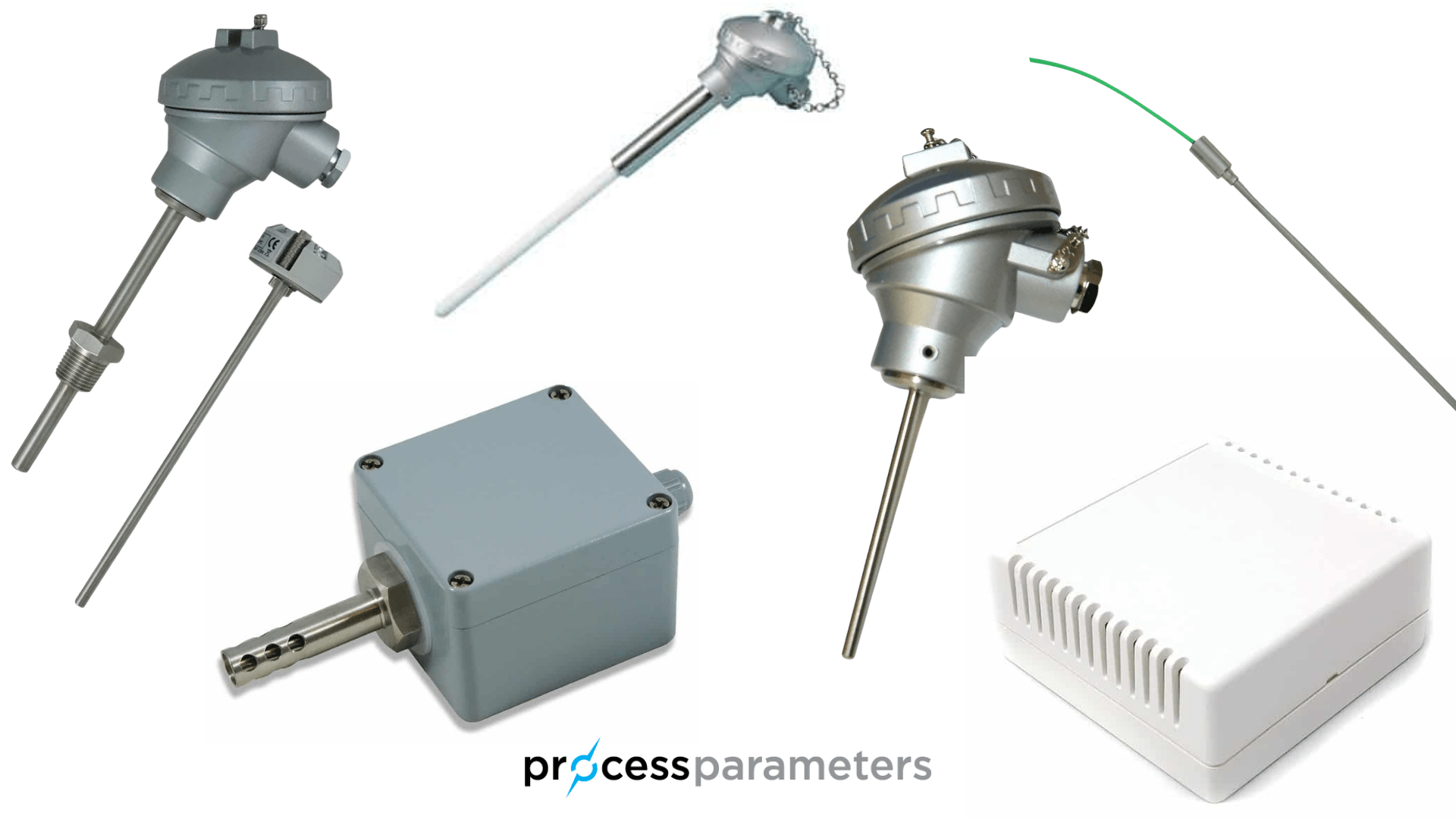What Is A Temperature Sensor?
Temperature Sensors: Types, Applications, Benefits, Design
A temperature sensor electronically detects the temperature of liquids, solid objects and gases.
Temperature-detecting devices can be contact or non-contact, and work by utilising the conversion of heat into electronic voltages to give an accurate temperature reading.
The reading will be displayed on a screen or used to trigger a series of events, such as turning on a fan to cool down an overheating engine.
Different temperature sensors feature differing technology to measure how hot or cold an environment is. Choosing the right temperature sensor device depends on what is being measured, how extreme the temperatures may be, and the required accuracy and size.
In this post, we’ll cover the different temperature sensor types, their uses, and how to choose the most suitable device for you.
Industrial Temperature Sensor Types for Temperature Measurement
Thermocouple
A thermocouple temperature sensor consists of two different metals formed into wires, that are joined to create a junction. When this junction is heated up or cooled down, it generates a small electrical voltage. This reaction is known as the thermoelectric effect or the ‘Seebeck’ effect. A thermocouple sensor accurately detects and records the temperature of the voltage.
Thermistor Sensor
Thermistors use a sensing element to measure temperature. They consist of a resistor that changes value based on how hot or cold something is. The elements are small, either glass or epoxy coated, and are one of two different types: Negative Temperature Coefficient (NTC) and Positive Temperature Coefficient (PTC). NTC has less resistance at higher temperatures, and PTC has more resistance at higher temperatures.
Platinum Resistance Thermometer (also known as RTDs and Pt100)
Platinum Resistance Thermometer (PRT) and Resistance Temperature Detector (RTD) are both names for the same type of sensor technology.
PRTs, like thermistors, measure resistance to detect temperature and connect to a circuit but have a wider temperature range – including extreme temperatures.
Temperature Probe
A temperature probe is not a type of temperature sensor in itself. Temperature probes utilise one of the three types of contact temperature sensing technology. A probe can be created using a thermocouple, thermistor, or PRT/RTD.
Infrared
Heat makes atoms move, and the speed of movement increases as temperatures increase. This movement emits thermal radiation, which infrared temperature sensors can detect using a thermopile, which is a series of thermocouple sensors. The thermopile converts the infrared radiation into heat, which is converted into a measurable voltage.
Temperature Sensor Applications & Uses
What is a temperature sensor used for? These days, most appliances and electronic equipment will contain a temperature-detection element of some sort.
From our hand-held devices to huge temperature-controlled factories, sensors keep us safe, improve machine longevity and keep technology working at its best.
The most common temperature sensor applications include:
- Household appliances
- Personal electronic devices
- Vehicles and engines
- Heating, ventilation and air conditioning
- Refrigeration appliances and storage
- Medical, biotech, and laboratories
- Machinery and components

How to Choose a Temperature Sensor
Choosing the right sensor to measure temperature for an application depends on a number of factors. These questions might act as a good starting point for selecting a sensor:
- What is the necessary temperature range?
- What is being measured? I.e. Material, object, substance, liquid, gas etc.
- Does the sensor need to detect, and function accurately in, extreme heat or cold conditions?
- What degree of accuracy is required?
- How big or small does the sensor need to be?
- How will the sensor be packaged into the application?
- Are there any industry standards to work to?
Process Parameters offers stock and bespoke temperature measurement, control and recording solutions for various industries. We work with customers to solve a variety of demands across the full temperature spectrum from cryogenic temperatures to molten metals.
Get in touch with your requirements, and we’ll work together to find the right product for your project.
How do Temperature Sensors Work?
Temperature sensors work by converting temperature variations into electrical signals. Common types include thermocouples, resistance temperature detectors (RTDs), and thermistors.
Thermocouples use two different metal wires joined at one end; temperature changes generate a voltage difference. RTDs rely on the change in electrical resistance of materials like platinum with temperature; resistance increases as temperature rises.
Thermistors are temperature-sensitive resistors with resistance that varies significantly with temperature. Modern temperature sensors often integrate these principles with electronic circuits to produce precise and linear output signals, which can be read and interpreted by instruments or control systems, allowing for accurate temperature measurement and control in various applications.
Final Thoughts
A temperature sensor takes a reading of the environment or object temperature and turns it into an output. This might be in the form of a digital reading or a subsequent action.
Some temperature sensors require physical contact, and some are non-contact. Almost all sensors for temperature will consist of thermocouples, thermistors, or resistance temperature detection technology.
If you have any questions, please do not hesitate to contact the team at Process Parameters. Call us at 01628 778688 or email us here.
Send An EnquiryFAQs
What is a sensor?
A sensor is a device or element that detects and measures physical properties or changes in the environment and converts them into an electrical or digital signal. Sensors are used in various applications, including temperature measurement, pressure sensing, proximity detection, and more, to provide valuable data for control, monitoring, and automation purposes.
What is temperature detection?
Temperature detection refers to the process of measuring and identifying the temperature of an object, environment, or individual. It is achieved using various devices like thermometers, infrared sensors, or thermal cameras for monitoring and analysis purposes.
How does a temperature sensor work?
Temperature sensors are most likely one of three types: Thermocouple, RTD, and Thermistor.
Thermocouples display readings or trigger heating/cooling by measuring the electrical voltage between two different metals at the point of contact. The voltage corresponds to how hot or cold an object, liquid, or atmosphere is.
A thermistor, short for thermally sensitive resistor, changes value with the temperature due to the increase or decrease of resistance with hot or cold temperatures.
RTDs, Resistance Temperature Detectors, measure resistance to detect temperature and connect to a circuit. They have a wide temperature range – including extreme temperatures.
Why do we need a temperature sensor?
Temperature sensors are necessary to keep a device or machinery working within its optimum temperature range, to prevent damage, danger and malfunctioning. The output of a temperature sensor will either be a series of events, such as turning on heaters in a furnace to heat a product, or a temperature reading displayed on a screen.
Which temperature sensor is best?
There is no definitive answer as the right temperature sensor will depend on the application. A Platinum Resistance Thermometer (PRT) or Resistance Temperature Detector (RTD)s can be better for low to mid-range temperatures and those requiring high accuracy. Thermocouples are better for extreme temperatures and where a robust sensor is necessary. Speak with our experts for tailored temperature sensor advice.
What devices use temperature sensors?
Temperature sensors can be found in almost all appliances and devices across a multitude of industries. They’re regularly used in our homes and personal electronic devices, in transport, in medical devices, food processing, HVAC and other temperature regulating systems, laboratories and other bio-industries, manufacturing and much more.
Related Articles:
- What Is A Temperature Sensor?
- 5 Different Types of Thermal Sensor
- What’s The Difference Between an RTD and a Thermocouple?
- How To Check if You Have a Faulty Temperature Sensor
- What is an RTD Sensor?
- Comparing Contact and Non-Contact Temperature Sensors
- What is a Temperature Transmitter?
- Guide to Industrial Temperature Sensor Devices
- What is a Thermocouple?
- What is a Pyrometer?
- What is a Thermometer?

